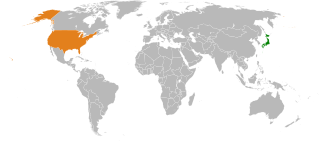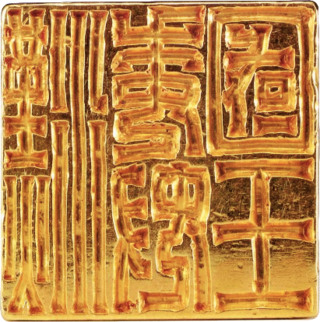Related Research Articles
Treaty ports were the port cities in China and Japan that were opened to foreign trade mainly by the unequal treaties forced upon them by Western powers, as well as cities in Korea opened up similarly by the Qing dynasty of China and the Empire of Japan.

In the field of international relations, a sphere of influence is a spatial region or concept division over which a state or organization has a level of cultural, economic, military or political exclusivity.

Containment was a geopolitical strategic foreign policy pursued by the United States during the Cold War to prevent the spread of communism after the end of World War II. The name was loosely related to the term cordon sanitaire, which was containment of the Soviet Union in the interwar period.
Westernization, also Europeanisation or occidentalization, is a process whereby societies come under or adopt what is vaguely considered to be Western culture, in areas such as industry, technology, science, education, politics, economics, lifestyle, law, norms, mores, customs, traditions, values, mentality, perceptions, diet, clothing, language, writing system, religion, and philosophy. During colonialism it often involved the spread of Christianity.

The Open Door Policy is the United States diplomatic policy established in the late 19th and early 20th century that called for a system of equal trade and investment and to guarantee the territorial integrity of Qing China. The policy was created in U.S. Secretary of State John Hay's Open Door Note, dated September 6, 1899, and circulated to the major European powers. In order to prevent the "carving of China like a melon," as they were doing in Africa, the Note asked the powers to keep China open to trade with all countries on an equal basis and called upon all powers, within their spheres of influence to refrain from interfering with any treaty port or any vested interest, to permit Chinese authorities to collect tariffs on an equal basis, and to show no favors to their own nationals in the matter of harbor dues or railroad charges. The policy was accepted only grudgingly, if at all, by the major powers, and it had no legal standing or enforcement mechanism. In July 1900, as the powers contemplated intervention to put down the violently anti-foreign Boxer uprising, Hay circulated a Second Open Door Note affirming the principles. Over the next decades, American policy-makers and national figures continued to refer to the Open Door Policy as a basic doctrine, and Chinese diplomats appealed to it as they sought American support, but critics pointed out that the policy had little practical effect.

The East–West Center (EWC), or the Center for Cultural and Technical Interchange Between East and West, is an education and research organization established by the U.S. Congress in 1960 to strengthen relations and understanding among the peoples and nations of Asia, the Pacific, and the United States. Suzanne Vares-Lum serves as its president and chief executive, where it is headquartered in Honolulu at the University of Hawaiʻi at Mānoa.

International relations between Japan and the United States began in the late 18th and early 19th century with the diplomatic but force-backed missions of U.S. ship captains James Glynn and Matthew C. Perry to the Tokugawa shogunate. Following the Meiji Restoration, the countries maintained relatively cordial relations. Potential disputes were resolved. Japan acknowledged American control of Hawaii and the Philippines, and the United States reciprocated regarding Korea. Disagreements about Japanese immigration to the U.S. were resolved in 1907. The two were allies against Germany in World War I.
Akira Iriye is a historian of diplomatic history, international, and transnational history. He taught at University of Chicago and Harvard University until his retirement in 2005.

Yoshimi Takeuchi was a Japanese Sinologist.
The Hamilton Library at the University of Hawaiʻi at Mānoa is the largest research library in the state of Hawaii. The Library serves as a key resource for the flagship Manoa campus as well as the other University of Hawaiʻi system campuses.

East Asia is a region of Asia, which is defined in both geographical and ethno-cultural terms. The modern states of East Asia include China, Japan, Mongolia, North Korea, South Korea, and Taiwan. Hong Kong and Macau, two small coastal cities located in the south of China, are autonomous regions under Chinese sovereignty. The economies of Japan, South Korea, China, Taiwan, Hong Kong, and Macau are some of the world's largest and most prosperous economies. East Asia borders Siberia and the Russian Far East to the north, Southeast Asia to the south, South Asia to the southwest, and Central Asia to the west. To the east is the Pacific Ocean and to the southeast is Micronesia.

The Japanese Problem, also referred to as the Japanese Menace or the Japanese Conspiracy, was the name given to racial tensions in Hawaii between the European-American sugarcane plantation owners and the Japanese immigrants hired to work in the cane fields.

The history of China–Japan relations spans thousands of years through trade, cultural exchanges, friendships, and conflicts. Japan has deep historical and cultural ties with China; cultural contacts throughout its history have strongly influenced the nation – including its writing system architecture, cuisine, lculture, literature, religion, philosophy, and law.
Jon Stewart is an American philosopher and historian of philosophy. He specializes in 19th century Continental philosophy with an emphasis on the thought of Kierkegaard and Hegel. He has also worked in the field of Scandinavian Studies and has made the culture of the Danish Golden Age better known internationally. Stewart currently works as a researcher at the Institute of Philosophy at the Slovak Academy of Sciences.

Richard Joseph Jensen is an American historian. He was a professor of history at the University of Illinois, Chicago, from 1973 to 1996. He has worked on American political, social, military, and economic history as well as historiography and quantitative and computer methods. His work focuses on Midwestern electoral history, and he has authored The Winning of the Midwest and Historian's Guide to Statistics.
The bibliography covers the main scholarly books, and a few articles, dealing with the History of Japan

The history of Japanese foreign relations deals with the international relations in terms of diplomacy, economics and political affairs from about 1850 to 2000. The kingdom was virtually isolated before the 1850s, with limited contacts through Dutch traders. The Meiji Restoration was a political revolution that installed a new leadership that was eager to borrow Western technology and organization. The government in Tokyo carefully monitored and controlled outside interactions. Japanese delegations to Europe brought back European standards which were widely imposed across the government and the economy. Trade flourished, as Japan rapidly industrialized.
East Asia–United States relations covers American relations with the region as a whole, as well as summaries of relations with China, Japan, Korea, Taiwan and smaller places. It includes diplomatic, military, economic, social and cultural ties. The emphasis is on historical developments.
Iga Mori (毛利伊賀) was a Japanese physician who practiced in Hawaii. He was an active community leader who helped to found the Kuakini Medical Center.
The history of China–United States relations covers the relations of the United States with the Qing and Republic eras. For history after the 1949 founding of the People's Republic of China, see China–United States relations.
References
- ↑ "Jon Davidann". www.hpu.edu. Retrieved 2023-03-30.
- ↑ Fujii, George (2019-05-27). "H-Diplo Roundtable XX-40 on The Limits of Westernization: American and East Asian Intellectuals Create Modernity, 1860-1960". H-Diplo. XX (40): 1024–1025. Retrieved 30 March 2023.
- ↑ Kuo, Karen (2022). "Jon Thares Davidann. The Limits of Westernization: American and East Asian Intellectuals Create Modernity, 1860–1960". American Historical Review. 127 (2): 1024–1025. doi: 10.1093/ahr/rhab595 . Retrieved 30 March 2023.
- ↑ "Featured Author". Routledge: Taylor & Francis Group. Routledge. Retrieved 29 March 2023.
- ↑ Davidann, Jon. "The Myth of Westernization". Aeon. Aeon Magazine. Retrieved 29 March 2023.
- ↑ Matray, James (2014). "Editorial". The Journal of American-East Asian Relations. 21 (3): 209–13 – via JSTOR.
- ↑ Fidell, Jay. "What can we Learn from US Business Cycles to help us Deal with the Impact of Covid (History Lens)". ThinkTech Hawaii. Retrieved 2023-03-30.
- ↑ Pye, Lucian (2003). "Review of Trans-Pacific Relations: America, Europe, and Asia in the Twentieth Century, by R. Jensen, J. Davidann, & Y. Sugita". Foreign Affairs. 82 (6): 172–172 – via JSTOR.
- ↑ Phillips, Steve (2004). "Review of Trans-Pacific Relations: America, Europe, and Asia in the Twentieth Century., by R. Jensen, J. Davidann, & Y. Sugita". The Journal of Asian Studies. 63 (1): 135–136 – via JSTOR.